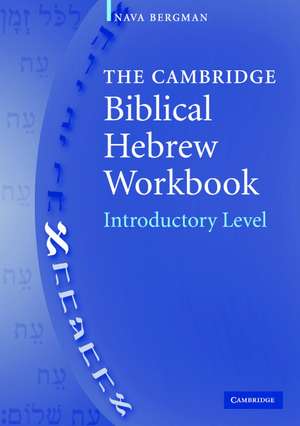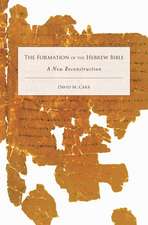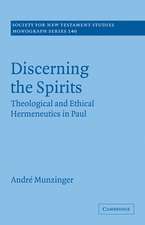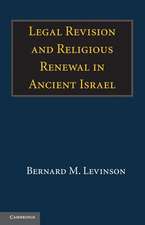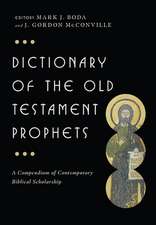The Cambridge Biblical Hebrew Workbook: Introductory Level
Autor Nava Bergmanen Limba Engleză Paperback – 6 apr 2005
| Toate formatele și edițiile | Preț | Express |
|---|---|---|
| Paperback (1) | 474.18 lei 6-8 săpt. | |
| Cambridge University Press – 6 apr 2005 | 474.18 lei 6-8 săpt. | |
| Hardback (1) | 856.67 lei 6-8 săpt. | |
| Cambridge University Press – 6 apr 2005 | 856.67 lei 6-8 săpt. |
Preț: 474.18 lei
Preț vechi: 532.79 lei
-11% Nou
Puncte Express: 711
Preț estimativ în valută:
90.73€ • 94.99$ • 75.08£
90.73€ • 94.99$ • 75.08£
Carte tipărită la comandă
Livrare economică 05-19 aprilie
Preluare comenzi: 021 569.72.76
Specificații
ISBN-13: 9780521533690
ISBN-10: 0521533694
Pagini: 392
Ilustrații: black & white illustrations
Dimensiuni: 170 x 244 x 20 mm
Greutate: 0.76 kg
Editura: Cambridge University Press
Colecția Cambridge University Press
Locul publicării:Cambridge, United Kingdom
ISBN-10: 0521533694
Pagini: 392
Ilustrații: black & white illustrations
Dimensiuni: 170 x 244 x 20 mm
Greutate: 0.76 kg
Editura: Cambridge University Press
Colecția Cambridge University Press
Locul publicării:Cambridge, United Kingdom
Cuprins
1. Hebrew alphabet; Vowel signs and their pronunciation; 2. Dissimilarity between sounds and spelling; Dagesh; Vowel letters; Silent Áleph; Diphthongs; Word stress; 3. 'Long' and 'short' vowels; Vowel categories; Full and simple vowels; Transliteration of vowels; Shva; Supporting vowels for gutterals; Relationship between consonants and vowels; Verbless clause; Independent personal pronouns in singular; 4. Syllable types; Consonant and vowel clusters; Syllable division; Qamets-/o/; Basic rule of vocalisation; 5. Relationship between vowels and stress; Unchangeable and changeable vowels; Regular vowel change; Definite article; Adjectives and nouns: inflection of gender and number; Independent personal pronouns in plural; 6. Special readings (Qere); Inseparable prepositions; Usage of adjectives; Accent signs and pause; 7. Word formation in general; Unchangeable and changeable consonants; Regular consonant change; Unchangeable and changeable root types; Inseparable prepositions followed by YHWH; 8. Conjunction and Demonstrative pronouns; Noun types; Regular masculine nouns; Regular feminine nouns; Penultimate nouns; 9. Twin-consonant nouns; Irregular nouns; Formation of nouns and adjectives; Vowel raising ('attenuation'); Existence/non-existence; Have/have not; Full and defective writing; 10. Nouns: free and bound forms; Noun chains; Adjective-plus-noun chain; Quantifier 'kol'; 11. Pronouns: attached forms; Prepositions and adverbs with 'singular' attached pronouns; Nouns in singular with attached pronouns; 12. Prepositions with 'plural' attached pronouns; Nouns in plural with attached pronouns; Questions; Sound changes across word boundaries; More about sound changes in pause; 13. Verb system; Perfect in general: form and meaning; (Qal, the G-stem) perfect: (unchangable verbs), verbs with gutturals, Áleph verbs, the irregular verb; Vowel lowering (Philippi's Law); Verbal clause; 14. Object marker; Direction marker; Verbal clause with variant word order; Verbal clause with an additional personal pronoun; Particles-as-intensifiers; Denoting immediate presence; 15. Perfect: vav/yod (hollow) verbs, twin-consonant verbs, vav/yod verbs; Relative clauses; Usage of the verb 'be'; 16. Imperfect in general: form and meaning; Imperfect (unchangeable verbs), verbs with gutturals, Áleph verbs, the irregular verbs; 17. Imperative; Lengthened imperfect; Shortened imperfect; Negative commands and prohibitions; Particle-as-intensifier; 18. Participles in general; Participles: form, usage and negation; Participles with tense markers; Conjunctions; 19. Infinitives in general; Infinitives: form, usage and negation; Quotation marker; 20. Verb chains; Inverting-vav; Usage of verb chains; Expression of purpose and result; Perfect with attached object pronouns; 21. (The N-stem): form and meaning; Imperfect and imperative with attached object pronouns; 22. (The D- and Dp-stems): form and meaning; 23. (The HtD-stem): form and meaning; 24. (The H- and Hp-stems): form and meaning; 25. Imperfect: Áleph verbs; Imperfect, imperative and infinite: vav/yod verbs, nun verbs and vav/yod verbs; 26. 'One another' (expression of reciprocity); Verbs with two direct objects (double transitivity); Time frame; Expression of wish; Adverbs and adverbial constructions; 27. Imperfect vav/yod verbs and twin-consonant verbs; vav/yod verbs and twin consonant verbs; Oaths; 28. Numerals; Denoting age; Conditional clauses; Four styles of Biblical prose: text samples; I. Narrative texts; II. Legal texts; III. Parables and proverbs; IV. Prophetic speeches; Appendix I. Hebrew via Hebrew names; Appendix II. Regular sound changes in Hebrew; Appendix III. Guide to grammatical terms; Hebrew-English vocabulary; English-Hebrew vocabulary; Key.
Recenzii
'These text samples are well chosen, and are annotated with supplementary new vocabulary, and guidelines on how to make optimal use of them. The workbook contains a number of other user-friendly devices … Exploration of the layout and variety of exercises contained in this workbook shows that much care and practical experience has gone into the production of this excellent tool, and that the author has neither oversimplified nor unduly complicated the endeavour of learning Biblical Hebrew for beginning students. She has provided an excellent alternative approach, and enriched this with numerous practical exercises, which, if faithfully and systematically carried out, should produce a rich harvest.' Journal of Semitic Studies
Notă biografică
Descriere
A comprehensive introductory workbook for students of Biblical Hebrew at colleges, seminaries and universities.
